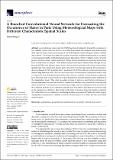A Branched Convolutional Neural Network for Forecasting the Occurrence of Hazes in Paris Using Meteorological Maps with Different Characteristic Spatial Scales
Author(s)
Wang, Chien
Downloadatmosphere-15-01239.pdf (5.056Mb)
Publisher with Creative Commons License
Publisher with Creative Commons License
Creative Commons Attribution
Terms of use
Metadata
Show full item recordAbstract
A convolutional neural network (CNN) has been developed to forecast the occurrence of low-visibility events or hazes in the Paris area. It has been trained and validated using multi-decadal daily regional maps of many meteorological and hydrological variables alongside surface visibility observations. The strategy is to make the machine learn from available historical data to recognize various regional weather and hydrological regimes associated with low-visibility events. To better preserve the characteristic spatial information of input features in training, two branched architectures have recently been developed. These architectures process input features firstly through several branched CNNs with different kernel sizes to better preserve patterns with certain characteristic spatial scales. The outputs from the first part of the network are then processed by the second part, a deep non-branched CNN, to further deliver predictions. The CNNs with new architectures have been trained using data from 1975 to 2019 in a two-class (haze versus non-haze) classification mode as well as a regression mode that directly predicts the value of surface visibility. The predictions of regression have also been used to perform the two-class classification forecast using the same definition in the classification mode. This latter procedure is found to deliver a much better performance in making class-based forecasts than the direct classification machine does, primarily by reducing false alarm predictions. The branched architectures have improved the performance of the networks in the validation and also in an evaluation using the data from 2021 to 2023 that have not been used in the training and validation. Specifically, in the latter evaluation, branched machines captured 70% of the observed low-visibility events during the three-year period at Charles de Gaulle Airport. Among those predicted low-visibility events by the machines, 74% of them are true cases based on observation.
Date issued
2024-10-17Department
Massachusetts Institute of Technology. Department of Earth, Atmospheric, and Planetary SciencesJournal
15
Publisher
Multidisciplinary Digital Publishing Institute
Citation
Wang, C. A Branched Convolutional Neural Network for Forecasting the Occurrence of Hazes in Paris Using Meteorological Maps with Different Characteristic Spatial Scales. Atmosphere 2024, 15, 1239.
Version: Final published version